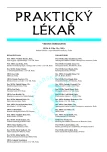Insights into the pathogenesis of autism spectrum disorders from the molecular and cellular level
Authors:
A. Strunecká 1; R. L. Blaylock 2
Authors‘ workplace:
Laboratoř biochemické neurofarmakologie
Ústavu lékařské biochemie 1. LF UK
Univerzita Karlova, Praha
Přednosta: prof. MUDr. Stanislav Štípek, DrSc.
; Belhaven College, Jackson, Mississippi, USA
2
Published in:
Prakt. Lék. 2008; 88(2): 78-81
Category:
Various Specialization
Overview
Despite the great array of observations, the etiopathogenesis of the autism spectrum disorders (ASD) is poorly defined. Our review offers evidence that most heterogeneous symptoms of ASD might have a common set of pathophysiological events at cellular level closely connected with dysregulation of glutamatergic neurotransmission in the brain with excitotoxicity as a common underlying mechanism. The suggested unifying hypothesis offers the means for efficient prevention and amelioration of ASD.
Key words:
autism, excitotoxicity, glutamatergic neurotransmission, excitatory amino acids.
Sources
1. Aldred, S., Moore, K.M, Fitzgerald, M., Waring, R.H. Plasma amino acid levels in children with autism and their families. J. Autism. Dev. Disorder 2003, 33, 1, p. 93-97.
2. Autism Genome Project Consortium. Mapping autism risk loci using genetic linkage and chromosomal rearrangements. Nat. Genet. 2007, 3, p. 319-328.
3. Blaylock, R.L. Excitotoxins, the taste that kills. USA: Health Press NA Inc, 1997.
4. Blaylock, R.L. The central role of excitotoxicity in autism spectrum disorder. JANA 2003, 6, p.10-21.
5. Blaylock, R.L. Excitotoxicity, A possible central mechanism in fluoride neurotoxicity. Fluoride 2004, 37, p. 264-277.
6. DeVito, T.J., Drost, D.J., Neufeld, R.W. et al. Evidence for cortical dysfunction in autism, a proton magnetic resonance spectroscopic imaging study. Biol. Psychiatry 2007, 61, p. 465-473.
7. Garstang, J., Wallis, M. Randomized controlled trial of melatonin for children with autistic spectrum disorders and sleep problems. Child Care Health Dev. 2006, 32, p. 585-589.
8. Hara, H. Autism and epilepsy: a retrospective follow-up study. Brain Dev. 2007, 29, 8, p. 486-490.
9. Hrdlička, M., Hort, V. Pervazivní poruchy v dětství. Doporučené postupy. Projekt MZ ČR 2001.(www.cls.cz).
10. Chez, M.G., Burton, Q., Dowling, T. et al. Memantine as adjunctive therapy in children diagnosed with autistic spectrum disorders, an observation of initial clinical response and maintenance tolerability. J. Child. Neurol. 2007, 22, p. 574-579.
11. Jamian, S., Betancur, C., Quach, H. et al. Linkage and association of glutamate receptor 6 gene with autism. Mol. Psychiatry 2002, 7, p. 302-310.
12. Klenerová, V., Hynie, S. Existuje vztah mezi stresem, pamětí a silnými emocemi, jako jsou obavy a strach? Čs. fyziologie 2007, 56, 3, s. 97-103.
13. Lojková, D., Mareš, P. Metabotropní glutamátové receptory jako možný cíl antiepileptické terapie. Čs. fyziologie 2007, 56, 2, s. 60-68.
14. Mullenix, P.J., Denbesten, P.K., Schunior, A., Kernan, W.J. Neurotoxicity of sodium fluoride in rats. Neurotoxicol. Teratol. 1995, 17, p. 169-177.
15. Olney, J.W., Farber, N.B., Wozniak, D.F. et al. Environmental agents that have the potential to trigger massive apoptotic neurodegeneration in the developing brain. Environ. Health Perspect 2000, 108, p. 383-388.
16. . Excitotoxicity, apoptosis and neuropsychiatric disorders. Curr. Opin. Pharmacol. 2003, 3, p. 101-109.
17. Page, L.A., Daly, E., Schmitz, N. et al. In vivo 1H-magnetic resonance spectroscopy study of amygdala-hippocampal and parietal regions in autism. Am. J. Psychiatry 2006, 163, p. 2189-2192.
18. Rice, C. Prevalence of autism spectrum disorders--autism and developmental disabilities monitoring network. Six sites, United States, 2000. MMWR Surveill. Summ. 2007, 56, 1, p. 1-11.
19. Strunecka, A., Patocka, J., Blaylock, R.L., Chinoy, N.J. Fluoride interactions: from molecules to disease. Current Signal Transduction Therapy 2007, 2, 3, p. 190-213.
20. Vargas, D.L., Nascimbene, C., Krisgnan, C. et al. Neuroglial activation and neuroinflammation in the brain of patients with autism. Ann. Neurol. 2005, 1, p. 67-81.
Labels
General practitioner for children and adolescents General practitioner for adultsArticle was published in
General Practitioner

2008 Issue 2
Most read in this issue
- Memory and its disturbances
- Current possibilities and problems of antiretroviral therapy
- The hoarding of possessions and animals
- Acute toxic hepatitis following consumption of a herbal preparation
